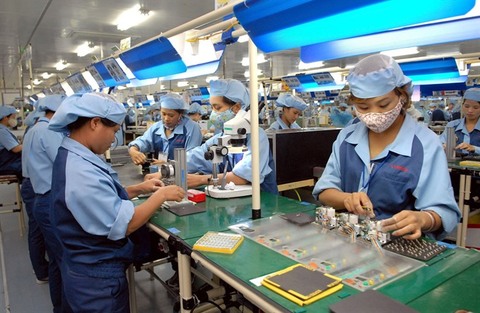
The manufacturing and processing sector attracted the largest FDI in the first four months of this year. — VNA/VNS Photo Pham Kien
Viet Nam’s foreign direct investment (FDI) disbursement continued a positive trend in the first four months of 2018 while there was a reduction in the registered FDI capital.
According to the Ministry of Planning and Investment’s Foreign Investment Agency (FIA), FDI projects in Viet Nam disbursed US$5.1 billion during the first four months, a year-on-year increase of 6.3 per cent.
Meanwhile, Viet Nam attracted a total registered FDI capital of $8.06 billion in the first four months, or 76.1 per cent of that in the same period in 2017.
By April 20, the country had 883 new FDI projects, with a total newly registered capital of $3.55 billion and some 303 projects registering to increase their capital at a total of $2.24 billion, or 51.5 per cent of that in the same period in 2017.
In the first four months of this year, foreign investors contributed capital and bought shares worth $2.27 billion, a year-on-year surge of 67 per cent.
According to FIA, foreign investors had invested their capital in 17 industries and fields during the first four months. Of this, the manufacturing and processing sector attracted the largest FDI, with a total registered capital of $4.52 billion, accounting for 56.1 per cent of the total investment.
The real estate sector ranked the second in terms of FDI attraction, with a total investment capital of $807.5 million, accounting for 10 per cent of the total. In the third place were the wholesale and retail sectors, with a total registered capital of $779 million, accounting for 9.7 per cent of the total.
Some 82 countries invested in projects in Viet Nam in the first four months. South Korea topped the list, with an investment of $2.32 billion, accounting for 28.7 per cent of the total investment. Japan ranked second, with a registered capital of approximately $1.29 billion, accounting for 16 per cent of the total investment. Singapore stood at the third place, with a registered investment of $808 million, accounting for 10 per cent of the total.
HCM City attracted the largest FDI in the first four months, with a total registered capital of $1.92 billion, accounting for 23.8 per cent of the total investment. Hai Phong ranked the second, with a registered capital of $1.03 billion, accounting for 12.8 per cent of the total. Ha Noi ranked the third, with a registered registered capital of $746 million, accounting for 9.25 per cent of the total.
New FDI strategy
Nguyen Mai, chairman of the Viet Nam Association of Foreign Investment Enterprises (VAFIE) and former Deputy Minister of Planning and Investment, told the online news website cafef.vn that to improve FDI attraction, the country needs to change the mindset in attracting investment.
"We need to change fundamentally the direction of foreign investment, by actively seeking investors for projects that Viet Nam is not able to do and needs FDI to support, promoting targeted investment instead of mass investment," Mai said.
In the period of 2018-30, Viet Nam should shift its strategy of attracting FDI away from profit-based incentives towards efficiency-based rewards, according to the FDI draft strategy for 2018-30 compiled by the Ministry of Planning and Investment (MPI) with support from the World Bank (WB).
The objective of the strategy is to identify priority sectors for FDI attraction in 2018-30, review the policy framework for FDI and recommend specific solutions and policies to help Viet Nam attract FDI into these priority areas.
The main focus of this strategy is to shift from attracting appropriate investors for available Vietnamese products to develop suitable products (including business environment and appropriate investment conditions) to the kind of investment that Viet Nam needs in the future. This shift will maximise the spillover effects and added value of FDI.
In addition, Viet Nam is heavily dependent on short-term tax exemptions, partial tariff exemptions, preferential tariffs and import tax exemptions to attract FDI. However, these mechanisms are no longer considered innovative and limit the potential for positive spillover effects.
WB experts suggested that Viet Nam should review the current investment incentive framework and the rebalancing of "profit-based" incentives with "efficiency-based" incentives.
Although Viet Nam is attracting investment efficiently from Japan and the Republic of Korea, in the long term, the country must attract more investors from other parts of the world such as Europe and the United States to diversify its FDI capital resources.
Mai also said that it is necessary to improve the quality of FDI, linking FDI and local private enterprises in the global value chain. The typical model is Samsung, which currently has 225 suppliers, including 25 first-tier suppliers, and strives to have 54 first-tier suppliers by 2020 and the authorities should also ask other investors to follow this model, Mai added. — VNS